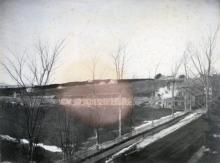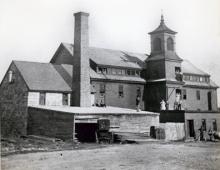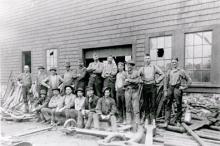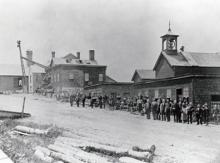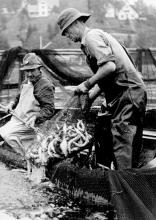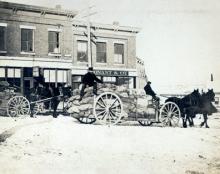Other Nineteenth Century Industries and Working Life
Maritime-related industries
Maritime enterprises required support from other industries. Shipbuilding relied on timber dealers for the right woods, blacksmithsBlacksmith
A craftsman who creates items by heating, cutting, and shaping iron or steel. for iron fittingsFittings
Generic term for the hardware such as blocks, shackles and cleats used to attach a vessels rigging to the spars, sails and hull., sailmakersSailmaker
One who makes and assembles canvas articles used on ships and boats, such as sails, awnings, and covers.
Read More to make and repair sails, and a ropewalkRopewalk ropehouse
A long building, usually 300-400 yards, in which ropes were made by twisting yarns into strands and strands into rope.
Read More in Castine to spin yarns into ropes. Boatbuilders made fishing boats and other small craft. Some lumber dealers like one in Brewer specialized in ship timber.
Mills, Factories, and Canneries
Camden’s waterpower facilitated factories. The Knox Woolen Mill was built there in 1868 to make feltsFelt
Fibers that are matted together, not woven, by heat, moisture, and/or pressure. Felts are used in paper making, and felted beaver fur hats were popular in seventeenth and eighteenth century Europe, encouraging the North American fur trade. for the paper industry. It first operated with water from the Megunticook River then added steam power, making its operations less dependent on water flow.
Camden also was home to the country’s largest forgeForge
A special fireplace, hearth, or furnace in which metal is heated before shaping. for ships’ anchors. The forge used waterpower from the Megunticook to operate trip hammersTrip hammer
A large power hammer used in metal working. The hammer is raised by water or other power, then allowed to fall by gravity.. The anchors weighed from 10 to 7,500 pounds.
Knowlton Brothers foundryFoundry
A place for producing castings in molten metal. in Camden made windlassesWindlass
A machine for lifting the anchor. Similar to the capstan but on a horizontal shaft., capstansCapstan
A machine used on board ship to provide mechanical power to raise the anchor, hoist yards, or lift heavy weights.
Read More, blocksBlock
A pulley, consisting of a frame or shell which supports a sheave or roller, over which ropes are run. There are many kinds of blocks. Blocks with ropes run through them form a tackle., and other items needed aboard ship.
Growing markets for sardinesSardines
Small herring, preserved in oil or sauces and canned. Maine had many sardine factories. led Maine to begin a thriving sardine canning business.
HerringHerring
Perhaps the world's most important food fish; there are sixteen species, with the Atlantic herring the dominant North Atlantic species. Fished heavily for centuries, today herring is caught in Maine waters primarily for lobster bait with some going to sardines. With new fishing technology there are serious concerns about overfishing. were caught in seine netsSeine
Any long net, having floats at the top edge and weights at the bottom, and hauled by its ends to close around a school of fish. or weirsWeir
A fence-like structure placed in water and usually constructed of stakes and brush to form one or more enclosures into which fish are led and trapped. and brought to canneries, which also processed mackerelMackerel
Atlantic mackerel is the species found in the North Atlantic. A schooling, bony, oily, strongly-flavored food fish, green above with dark blue bars and silvery color below. The commercial stock has rebounded since near collapse in the 1970s. Without ice they spoil quickly. They are caught in purse seines which produce relatively little bycatch and no bottom damage. Today most of Maine's mackerel fishery is recreational., salmonSalmon
A marine and freshwater food fish, inhabiting North Atlantic waters near the mouths of large rivers. Salmon are anadromous fish, entering rivers to spawn (lay eggs.) In Maine, salmon fishing was once a commercial, then a sport fishery; now wild salmon are an endangered species. Many are farm-raised., and lobstersLobster Homarus americanus
An edible crustacean, Homarus americanus refers to the species found in the North Atlantic.. The demand for canned lobster caused the fishery to grow so much that regulations were enacted to help preserve lobster populations.
Working Life in the Nineteenth Century
Much work in Maine was seasonal. While most shipping took place in the spring through late fall, it depended on production and on demand. Selling to both southern and northern markets often called for a winter schoonerSchooner
A sailing vessel of two or more masts, all fore-and-aft rigged. The Thomas W. Lawson, built in 1902, had seven masts. In comparison to a square-rigged vessel of comparable tonnage, a schooner is better for coastwise sailing. voyage to Florida or the West Indies. From spring to late fall, workers cut and milled timber, shipped ice, and quarried limestone and granite. Later in the century limeLime
Calcium oxide (CaO), obtained from limestone, and used in mortars, plasters, cement, bleaching powder, and in making paper, glass, and steel. quarries operated all year long, like granite quarries. January, February and March were the best months for ice harvesting and for cutting trees. In summer, fishermen caught lobsters, mackerel, and herring; and fished offshoreOffshore
In fisheries, fishing conducted further than 3 miles from land. These generally require larger vessels for overnight passages and work. in the Gulf of St. Lawrence and the Grand Banks.
Most workers worked at least a ten-hour day, six days a week when there was work. Days were sometimes regulated among the unionizedUnion
Unions are organizations of workers that use the strength of numbers to bargain with management over workers' wages, benefits, work hours, and conditions. Unions are normally organized by trade, such as quarrymen, teamsters, iron workers, etc. trades, but some non-union trades worked from sunrise to sunset. The eight-hour day was not accepted until the twentieth century.
During much of the late nineteenth century, pay for laborers ranged from about $1.50 to $2.50 per day, with no sick days or benefits. Wages could go up, but more often went down, especially when industries were in decline. Because of the seasonal occupations, workers often had no work 90 or more days per year.

